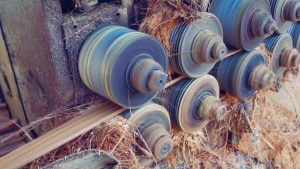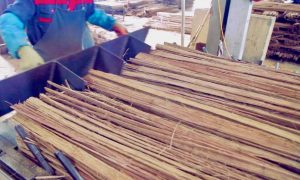Origin and types of bamboo
Bamboo wood is planks or beams made from bamboo fibers. Bamboo stems are sawn into strips. The strips are glued and pressed together under high pressure.
Bamboo is a type of grass and not a type of wood. Bamboo wood is therefore not wood but 'lignified' grass. Bamboo wood is used in the same applications as wood and can shrink and swell just like wood.
Two types of bamboo
Broadly speaking, there are two types of bamboo. Laminated bamboo and pressed bamboo . Although both types have a high stability and a very long lifespan, they are not equally suitable for every application. I use heavily pressed bamboo for my furniture.


Laminated
Many people know this type of bamboo from products such as cutting boards and knife blocks. Laminated bamboo consists of several long, laminated strips.
Pressed
This pressed bamboo wood is also known as strand-woven bamboo or bamboo composite. This species is generally less likely to be recognized as bamboo, but is often mistaken for hardwood. That is not very surprising: virtually no woody material is harder or stronger than heat-pressed bamboo.
Production of pressed bamboo
After the strands have reached the correct moisture percentage, they are heated in a mold and compressed under extremely high pressure. The thermal treatment turns the natural sugar molecules into caramel. This ensures the bond and also prevents the bamboo from rotting. In addition, the bamboo gets its beautiful, warm hue (caramel) by caramelizing the sugar. When heated to extremes, the bamboo takes on a deep dark brown color. That color is also called dark chocolate.













Benefits of bamboo
- Solid pressed bamboo is the sustainable replacement for hardwood
- Bamboo is also environmentally friendly and CO2 neutral, because they are made from a fantastic and inexhaustible raw material (bamboo of course!).
- Bamboo grows very quickly, there seem to be species that you can literally see growing. Partly because of these properties, bamboo is an attractive alternative to tropical hardwood species.
- Bamboo stems have a hardness comparable to oak wood. When processed into planks, it is completely rock hard and is one of the hardest types of wood.
- Bamboo naturally hardly expands and hardly shrinks.
- Bamboo forests remain intact because the roots of the plant immediately put out new shoots after being cut down.
The hardness of bamboo.
Solid bamboo is compressed to a density of around 1150 kg per cubic meter and around ten percent glue is used, this combination produces a very strong and durable material. This density is higher than most hardwood species.
Sustainability
Sustainability is one of the main reasons that bamboo is a good alternative to tropical hardwood. The bamboo trunk reaches full maturity in five years, while that period for trees that supply (tropical) hardwood is 60 to 120 years. In addition, bamboo continues to grow immediately after being cut, instead of the stump and roots dying. But what is even more remarkable about bamboo is that this type of grass is a true CO2 guzzler. Bamboo removes approximately five times as much CO2 from the air as tropical hardwood. All this means that bamboo is seen as the building material of the 21st century. In addition, bamboo is known for its long lifespan, hardness (which makes bamboo very resistant to vandalism) and high fire class.

